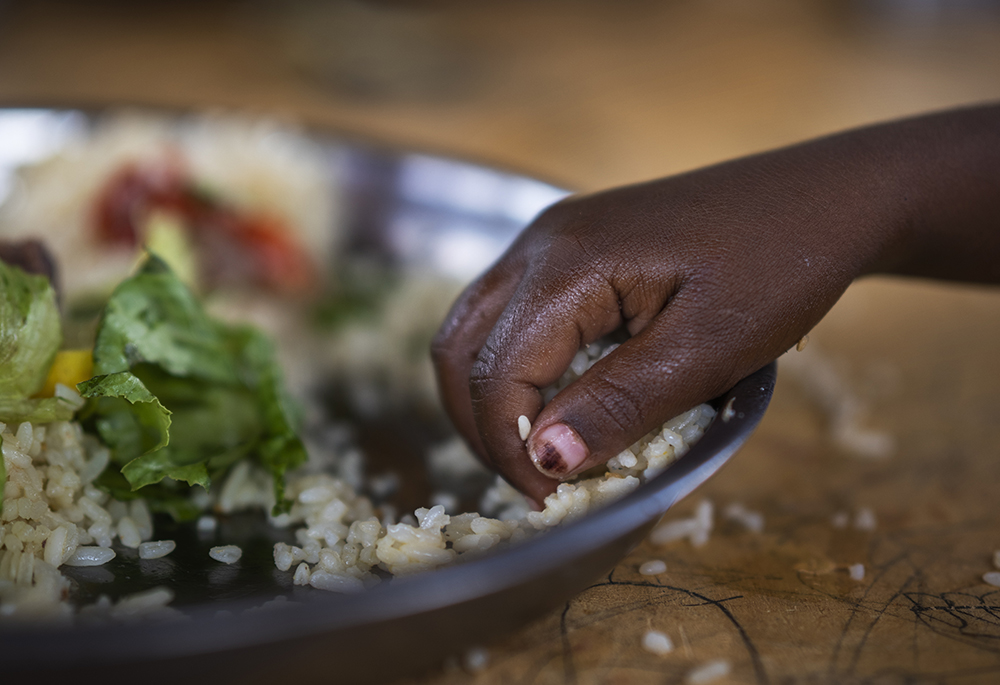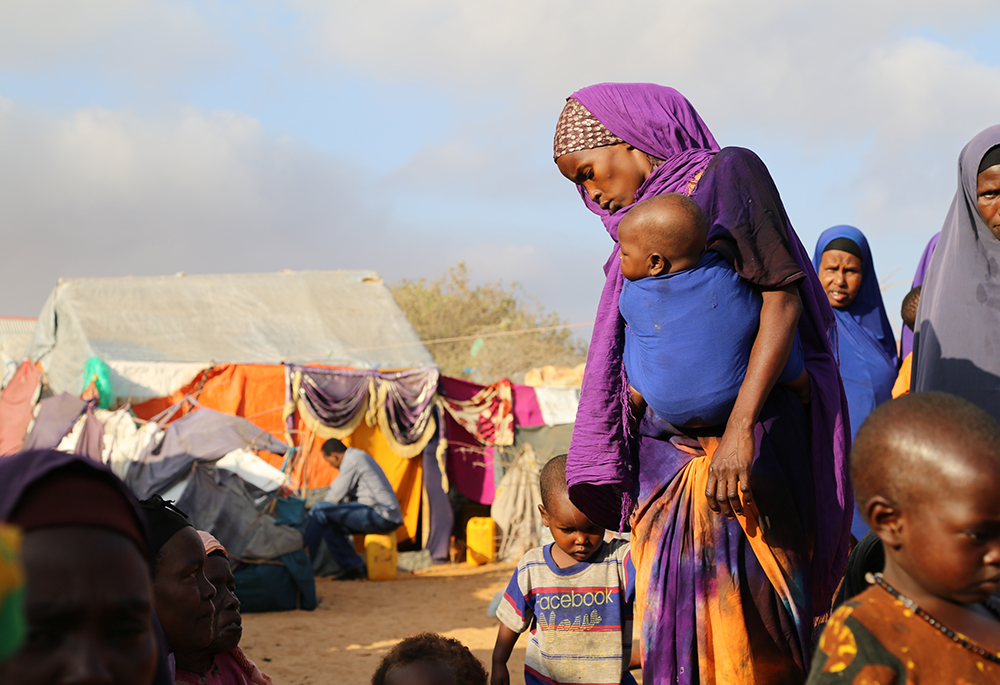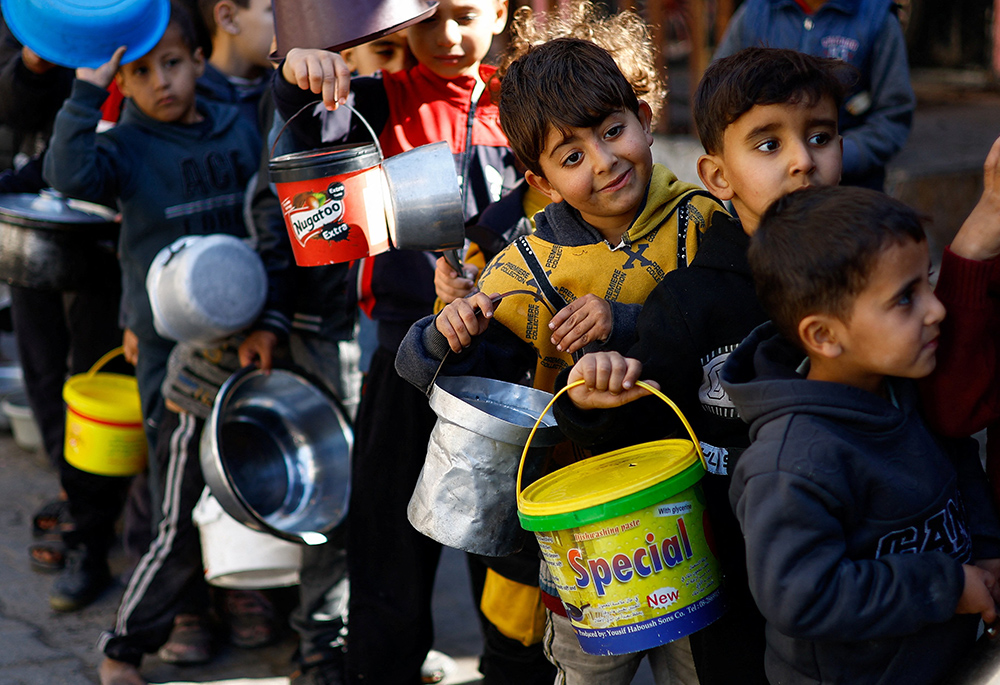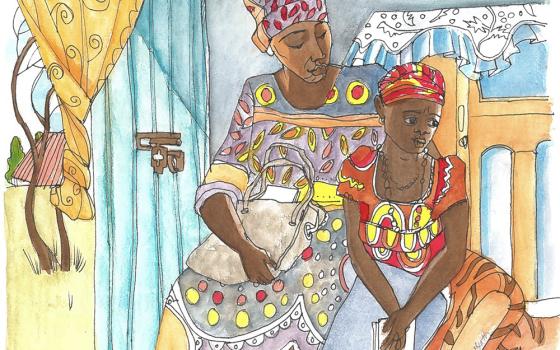
A girl eats at a school Sept. 19, 2022, in Dollow, Somalia. The Famine Early Warning Systems Network predicts that by July, parts of Somalia and eight other countries will be at internationally recognized emergency levels of food insecurity. (AP photo/Jerome Delay, File)
Katy Nembe Katonda remembers meeting the 2-year-old at the camp for people displaced by fighting in eastern Congo.
The deputy country representative for the British Catholic aid agency CAFOD said the child had "acute malnutrition. You could see the wounds on the hands, on the head, on the feet."
The child was part of a family unit of 10. A young mother in her early 20s was caring for her four children and five children of her sister, who was killed in the region's ongoing violence over minerals and resources.
"Seven of these children are under 10," Nembe recalled. She said the other children were not far from malnutrition — their hair was starting to turn yellow; as malnutrition progresses, hair falls out.
A tarp, supplemented by paper bags, gave them shelter from the rain.
"That is what they call home," since the woman fled violence with the children and traveled three days to the camp. The woman told Nembe she did not know her husband's whereabouts; he fled in another direction when attackers came.
Eastern Congo "has really been torn apart by ... continued conflict, which has definitely affected the common person's life," Nembe said, noting that, when they flee, people leave behind their crops and most of what they own.
The Famine Early Warning Systems Network, or FEWS NET, predicts that by July, parts of nine countries — Burkina Faso, Ethiopia, Yemen, Sudan, South Sudan, Somalia, Haiti, Mali and Nigeria — will be at internationally recognized emergency levels of food insecurity, marked by "very acute malnutrition and excess mortality." Some households in eastern Congo also will be at the emergency level. These projections include allowances for delivery of humanitarian aid between now and then.

Families affected by drought in Somalia are pictured in this 2017 photo. Parts of Somalia are expected to face famine by July. (Courtesy of Catholic Relief Services/Mohamed Sheikh Nor)
In Burkina Faso, some roads are blocked because of conflict and, in one province, "most food sources will be unavailable in July due to market supply shortages and exhaustion of the 2023 harvest, wild foods and irrigated gardens," reports FEWS NET, a project of the U.S. Agency for International Development. "However, if food aid is not delivered in sufficient quantities, then famine would likely occur," it states.
Famine is not a term that international agencies use lightly. The Integrated Food Security Phase Classification, or IPC, says "famine" is used when 20% of households face an extreme lack of food and 30% of children suffer from acute malnutrition. It notes that while food catastrophe can be classified at the household level — even in areas not classified as famine areas — a famine can only be classified at an area level.
Nell Bolton, a senior technical adviser for justice and peacebuilding for the U.S.-based Catholic Relief Services, or CRS, said "conflict has been the main driver" of food insecurity around the world.
Her colleague, Dina Brick, CRS senior technical adviser for food security, agreed that there are "really clear links between conflict and food insecurity." She said between 70% and 80% of people affected by acute food insecurity are in areas of conflict.
Advertisement
Brick recalled that, several years ago, she visited Central African Republic and talked to people who, because of the ongoing war and violence "were literally [hiding] in their fields, or away from their fields" and thus did not have access to food. She said when CRS went in with a food aid truck, staffers and their local partners had to call out to people and let them know who they were.
"People were literally afraid of any kind of vehicle coming in" because they did not know who was in the vehicle, she said.
In Africa's Sahel region, where conflict has been disrupting lives for 10 years, "People go to bed without food on a daily basis," said Mawuli Sablah, CRS West African regional technical adviser for nutrition, based in Burkina Faso. "If they're lucky enough, they might have one meal."
Sablah said in some areas of the world, food insecurity is caused by flooding, desertification, dryness, market systems or people still recovering from the impact of COVID-19; but in Sahel countries, "complex, multidimensional conflict" is a driving force.
"You are talking about contexts where there ... is conflict — severe conflict," Sablah said, noting that agencies "are not able to reach even certain communities."
A displaced woman and young man are seen at a camp Jan. 24, 2020, in Pissila, Burkina Faso. The Famine Early Warning Systems Network predicts that by July, parts of Burkina Faso, Ethiopia, Yemen, Sudan, South Sudan, Somalia, Haiti, Mali and Nigeria will be at internationally recognized emergency levels of food insecurity. (CNS/Reuters/Anne Mimault)
Long periods of food insecurity result in intergenerational malnutrition, he said.
"You see a child that, for example, is 5 years, and that child looks like a 2-year-old. So, the child is stunted," he said. "In some contexts, you have as much as 40% of children under 5 stunted and acutely wasted, [with] acute malnutrition."
Even when you take that child to a health center and try to provide some therapeutic food, when "you bring that child back home," there might not be clean water, not enough food.
"And so, it becomes a perpetual state," and for the rest of that life, the child is a liability to the family, because malnutrition affects the central nervous system, he said. Then a malnourished girl might become a malnourished mother and give birth to a malnourished child, perpetuating the cycle.
Catholic Relief Services offers programs to help mothers and children but also tries to prevent some of the malnutrition by fortifying the basic foods in its school feeding programs, he said.
Paula Casado Aguirregabiria, regional communications and fundraising officer for Jesuit Refugee Service in East Africa, said that, for decades, many South Sudanese lived in Sudan. However, when war broke out in Sudan last April, almost 400,000 South Sudanese returned home. So many returnees "definitely creates some tension" regarding food, Casado said.
The situation in South Sudan is complicated by climate change and by lack of international investment in South Sudan, she said. It is very dry where the people cross the border, and years of flooding have destroyed crops in other areas, she said.
Bolton and Brick emphasized that CRS works with local partner agencies, which are especially important in places like Burkina Faso.
"They're of the communities. They know the communities," said Brick. "They often are really aware of the conflict in communities."
Bolton said local partners know who has the most need and how to reach them. She said partners have "relationship networks," which are important for building trust and credibility.
In a guest essay in The New York Times in 2021, after a magnitude 7.2 earthquake struck Haiti, Michèle Montas, a Haitian journalist and former adviser to the U.N. stabilization mission in Haiti, or MINUSTAH, said it was important to trust "grassroots networks that are in direct contact with the victims and have a record of coordinating relief efforts."
"Haiti is challenging because they have numerous threats," Brick said. "They are on the path of hurricanes ... inflation has been really high for them," but also, there have been ongoing conflicts.
According to The Associated Press, Maria Isabel Salvador, U.N. special envoy to Haiti, told the U.N. Security Council Jan. 25 that her office had documented 8,400 victims of gang violence in 2023 — an increase of 122% over 2022. She said about 300 gangs control 80% of Port-au-Prince, the Haitian capital, but that the violence had reached central Haiti, where gangs steal livestock and crops, block irrigation systems and force poor farmers to pay for access to the land.
AP reported in November that The World Food Program said nearly half of the 1.7 million people in Haiti's Artibonite department alone were at risk of starvation.
The IPC and FEWS NET do not regularly monitor the Gaza Strip, but the IPC said the outbreak of war in October caused catastrophic levels of acute food insecurity.
"There is a risk of famine, and it is increasing each day that the current situation of intense hostilities and restricted humanitarian access persists or worsens," the IPC wrote in December. "The intensification of the hostilities, further reduction in access to food, basic services, and lifesaving assistance, and the extreme concentration or isolation of people in inadequate shelters or areas without basic services are major factors that contribute to increasing this risk."

Displaced Palestinian children wait to receive food at a distribution center In Rafah in the southern Gaza Strip Jan. 16, amid the ongoing conflict between Israel and the Palestinian Islamist group Hamas. (OSV News/Reuters/Ibraheem Abu Mustafa)
Joseph Hazboun, regional director of the Catholic Near East Welfare Association-Pontifical Mission in Jerusalem, spoke of "severe anemia and malnutrition among children." He said although Israel was allowing some food and water in, it was only allowing about 10% of what Gaza needed to recover. He also said that in November, Israel targeted and destroyed bakeries, "another sign of how Israel really intended to cause famine" to drive people out of Gaza.
Brick spoke of how conflict in one part of the world can affect people in another part of the world. Because of the impact of the 2022 Russian invasion of Ukraine and its effects on grain exports, people started noticing a global food crisis, she said.
But she said no matter where people are in the world, "We're wired to keep our families safe."
She said because of her job at CRS, she often thinks: "What would I do if I don't have the choice to go home tonight? ... If I don't know if I'm safe?"
Sablah lived in New Jersey for a little over a year when he worked for UNICEF, so he has seen life on both sides of the Atlantic.
"The inequity — it's very daunting, it's very clear," he said.
"We live in a global village ... there is enough for everybody," he said. "The human dignity needs to be prioritized over any other interests."







